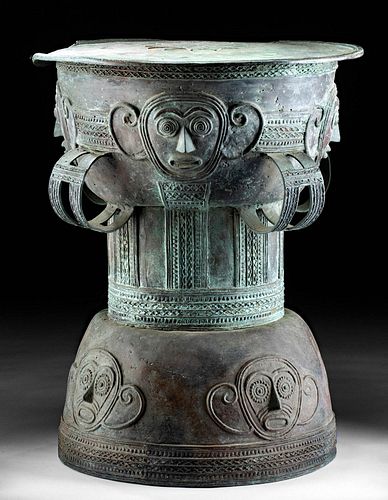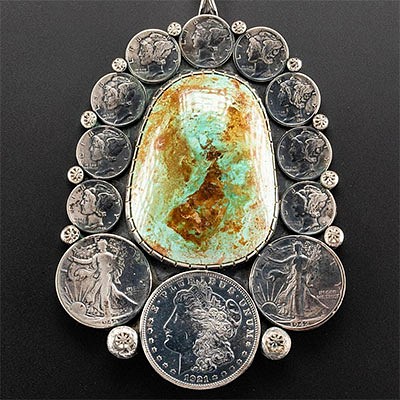Mid 20th C. Indonesian Alors Island Brass Moko Drum
Lot 115
About Seller
Artemis Gallery
686 S Taylor Ave, Ste 106
Louisville, CO 80027
United States
Selling antiquities, ancient and ethnographic art online since 1993, Artemis Gallery specializes in Classical Antiquities (Egyptian, Greek, Roman, Near Eastern), Asian, Pre-Columbian, African / Tribal / Oceanographic art. Our extensive inventory includes pottery, stone, metal, wood, glass and textil...Read more
Categories
Estimate:
$1,800 - $2,500
Absentee vs Live bid
Two ways to bid:
- Leave a max absentee bid and the platform will bid on your behalf up to your maximum bid during the live auction.
- Bid live during the auction and your bids will be submitted real-time to the auctioneer.
Bid Increments
| Price | Bid Increment |
|---|---|
| $0 | $25 |
| $300 | $50 |
| $1,000 | $100 |
| $2,000 | $250 |
| $5,000 | $500 |
| $10,000 | $1,000 |
| $20,000 | $2,500 |
| $50,000 | $5,000 |
| $100,000 | $10,000 |
| $200,000 | $20,000 |
About Auction
By Artemis Gallery
Feb 25, 2021
Set Reminder
2021-02-25 10:00:00
2021-02-25 10:00:00
America/New_York
Bidsquare
Bidsquare : American Frontier | Ethnographic | Tribal Art
https://www.bidsquare.com/auctions/artemis-gallery/american-frontier-ethnographic-tribal-art-6449
Featuring historical examples from the American, Spanish, and Mexican frontiers, as well as Native American, Ethnographic, Tribal, Oceanic, Spanish Colonial, more. All items offered for sale have been legally acquired, are legal to sell and are guaranteed to be as described or your money back. Artemis Gallery info@artemisgallery.com
Featuring historical examples from the American, Spanish, and Mexican frontiers, as well as Native American, Ethnographic, Tribal, Oceanic, Spanish Colonial, more. All items offered for sale have been legally acquired, are legal to sell and are guaranteed to be as described or your money back. Artemis Gallery info@artemisgallery.com
- Lot Description
Indonesia, Alors Island, mid 20th century. An hourglass-shaped brass drum known as a moko drum, decorated with expressive faces and pierced handles placed equidistantly around the body. The faces present spiraled eyes topped by an arched unibrow, a protruding nose, an open mouth, and very large, possibly zoomorphic ears. The lower visages also present with 'beaded' bands around the eyes and stylized whiskers. The openwork handles as well as the field of the vessel are decorated with bands of intricate patterns such as 'beaded', rope motifs, and cross-hatch motifs perhaps inspired by woven textile patterns. The top of the drum is enclosed with a disk of sheet brass to serve as the tympanum that is embellished with a bas-relief star motif, while the bottom is open. Mokos are still used today for ritual celebrations and as part of the marriage exchange on the island of Alor in the Indonesian archipelago. Traditionally a groom would give a moko to his wife's family as part of a dowry - and there is an endearing saying in Alor, "No moko, no marriage!". Size: 15125" W x 18.875" H (38417.5 cm x 47.9 cm)
Moko drums were traditionally created in East Java and were used on the Indonesian island of Alor as marriage gift exchanges and also traded for agricultural produce. On occasion, mokos were used as musical instruments for significant events. Older mokos are coveted and thought to house ancestral spirits. Find illustrations of moko drums in (Taylor & Aragon, 1991, p. 218) and Meulenbeld et al (1988, p. 204).
Provenance: private Hawaii, USA collection; ex Lissauer collection, Australia, 1960-2000
All items legal to buy/sell under U.S. Statute covering cultural patrimony Code 2600, CHAPTER 14, and are guaranteed to be as described or your money back.
A Certificate of Authenticity will accompany all winning bids.
We ship worldwide and handle all shipping in-house for your convenience.
#162559Expected age wear with cracks and bent sections to periphery of the tympanum. Some casting flaws and pinhole sized perforations here and there. Brass has developed a rich age patina of russet and blue-green hues.Condition
- Shipping Info
-
All shipping is handled in-house for your convenience. Your invoice from Artemis Gallery will include shipping calculation instructions. If in doubt, please inquire BEFORE bidding for estimated shipping costs for individual items.
-
- Buyer's Premium



 EUR
EUR CAD
CAD AUD
AUD GBP
GBP MXN
MXN HKD
HKD CNY
CNY MYR
MYR SEK
SEK SGD
SGD CHF
CHF THB
THB
















